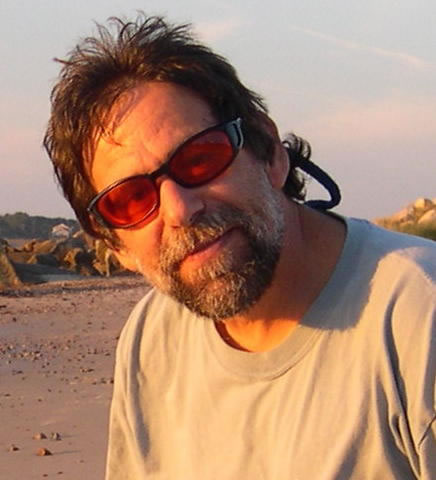Howard Drossman
Professor
Education
Higher Education Teaching & Employment
Professor of Environmental Education and TREE Semester Program Director, Colorado College, Colorado Springs, CO (July 2014-present)
Chair, Education Department, Colorado College, Colorado Springs, CO (Jan. 2021-July 2021, Jan. 2022-July 2022)
Professor of Environmental Science, Colorado College, Colorado Springs, CO (Sept. 2006-June 2014)
Executive Director, Catamount Center, Woodland Park, CO (May 2005-Dec. 2008)
Environmental Science Program Director, Environmental Science Program, Colorado College, Colorado Springs, CO (July 2000-June 2007)
Visiting Scientist, Marine Biological Laboratory Ecosystems Research Center, Woods Hole, MA (Sept. 2005 - June 2006)
Visiting Professor, International Sustainable Development Studies Institute, Chiang Mai, Thailand (Jan. 2006-March 2006)
Associate Professor of Chemistry and Environmental Science, Colorado College, Colorado Springs, CO (Sept. 1998-Aug. 2006)
Publications
* denotes undergraduate student
Drossman, H., “An Iterative and Adaptive Developmental Evaluation Framework: Case Study of the Teaching and Researching Environmental Education Semester.” Environmental Education Research, (in revision)
Arias, J-M, Drossman, H. 2021. “Power & Equity in Undergraduate Environmental Education: Loving Critique at the Colorado College TREE Semester,” Clearing Magazine, Fall.
Drossman, H., Gaia, S., Dawson, T., 2016. Development of an Integral-Motivated Lectical® Ecological Stewardship Assessment, Journal of Integral Theory and Practice.
*Harness, H., Drossman, H., 2012. “The Environmental Education Through Filmmaking Project.” In The Media, Animal Conservation and Environmental Education (J. Bewitt, ed.), Routledge.
*Harness, H., Drossman, H., 2011. “The Environmental Education Through Filmmaking Project.” Environmental Education Research, 17(6), 829-849, DOI:10.1080/13504622.2011.618626.
Drossman, H., Bennett, J., McGrath-Spangler, E., VanRoekel, L., Wells, K. E. 2011. “Assessment of a Constructivist-Motivated Mentoring Program to Enhance the Teaching Skills of Atmospheric Science Graduate Students.” Journal of College Science Teaching, 41(2), 72-81.
Drossman, H., 2012, “How Does an Automobile Engine Convert Heat to Work?,” in ChemConnections Activity Workbook, Anthony, S. and Mernitz, H. (eds.), New York: Norton.
Drossman, H., 2012, “How Does Engine Temperature Affect CO and NOx Production?” in ChemConnections Activity Workbook, Anthony, S. and Mernitz, H. (eds.), New York: Norton.
Hobbie, J. E., Hobbie, E. A., Drossman, H., Conte, M., Weber, J.C., Shamhart, J., *Weinrobe, M. 2009. "Mycorrhizal fungi supply nitrogen to host plants in Arctic tundra and boreal forests: 15N is the key signal." Canadian Journal of Microbiology, 55(1): 84-94.
Drossman, H. Chemical Speciation Analysis of Sports Drinks by Acid-Base Titrimetry and Ion Chromatography: A Challenging Beverage Formulation Project, Journal of Chemical Education, 2007, 84(1), 124-127.
Drossman, H. *Myers, J.B., Bower, N.W., 2006. Radioimmunoassay of Morphine in Urine from Ingestion of Poppy Seeds: A Research-Based Laboratory, Chem. Educator, 11, 1–6, DOI 10.1333/s00897061038a.
Hamann, H., Drossman, H., 2006. Integrating Watershed Management with Learning: the role of information transfer in linking educators and students with community watershed initiatives, Comparative Technology Transfer and Society, December, 4(3), 305–339.
Drossman, H., Laursen, S, Tikkanen, W., 2003. How Can We Reduce Automobile Air Pollution: A ChemConnections Module for General Chemistry Students, W.W. Norton & Company.
Drossman, H., Hamann, H, 2003. "Teaching Chemistry at the Watershed Level,” American Chemical Society Environmental Chemistry Section Abstracts, August. (extended abstract)
Abstracts & Presented Papers
Drossman, H., Gaia, S., Dawson, T., Development of an Integral-Motivated Lectical® Ecological Stewardship Assessment, Integral Theory Conference, Sonoma State University, CA. (2015)
Drossman, H., Giuffre, K., *Diefendorf, S., Carlson, S., Social Networks Analysis of Environmental Activists: The Role of Gender, Social Exclusion and the Definition of Sustainability, American Sociological Association National Meeting, Denver, CO. (2012)
Drossman, H., Titcombe, M., “Analysis of student satisfaction and achievement of learning objectives with traditional vs. environmentally-relevant POGIL exercises” American Chemical Society National Meeting, Anaheim, CA. (2011)
Foster, Susan Q., S. Denning, D. A. Randall, R. M. Johnson, J. Bergman, H. Drossman, L. Gardiner, B. Hatheway, R. Russell, B. Jones, J. Lanting, R. Pandya, L. Pitot, and D. Swartz, Understanding clouds, weather, climate, and modeling: education and outreach from the Center for Multi-scale Modeling of Atmospheric Processes, American Meteorological Society. (2008)
Invited Presentations
Franzen, R., Born, P., Drossman, H., McClain, L., Exemplary Higher Education Environmental Education Programs, NAAEE National Meeting, Tucson, AZ, October 13, 2022.
Franzen, R., Born, P., Bennett, B., Drossman, H., McClain, L., The Road to NAAEE Higher Education Accreditation: A Map for Success, NAAEE National Meeting, Tucson, AZ, October 12, 2022.
Drossman, H., A More Transformational Portfolio, CAEE Awards Symposium, Golden CO, November 4, 2021.
Drossman, H., An Introduction to Developmental Evaluation, CAEE Fall Conference (online), September 21, 2021.
Drossman, H., Two Generations of Professional Development, CAEE Fall Conference (online), September 17, 2020.
*Mazurek, J., Drossman, H. Developing Effective Environmental Educators, CAEE Annual Conference, March 16, 2019, Denver, CO.
Drossman, H., What Makes Learning Transformative?: Lessons from the TREE Semester, Colorado College Fall Conference, Colorado Springs, CO. (2018)
Honors & Certifications
NAAEE Distinguished Program (TREE Semester) (2017-2024)
CAEE Enos Mills Lifetime Achievement Award (2021)
CAEE Innovative Program Award (TREE Semester) (2018)
Master Environmental Educator Certification; Colorado Alliance for Environmental Education (2009-2016)
External Grants
NSF Noyce Student Research: (two student research stipends)-LDPA as a bridge between theory and practice; LESA as a tool to develop systems thinking ($8,000) (2021)
National Science Foundation Noyce Grant (Implementation chair): scholarships for teacher preparation (co-PI with Mike Taber (PI), Manya Whitaker and Tina Valtierra, $1,190,012) (2015)
National Science Foundation Science Technology Center: “Multi-scale Modeling of Atmospheric Processes,” sub-contract from Colorado State University (PI: David Randall) ($15,000 + 1 student summer fellowships) (2014)
Associated College of the Midwest Seminar in Advanced Interdisciplinary Learning (SAIL). “Contested Spaces:Exploring Multiple Perspectives on Land Stewardship in the Pikes Peak Region of Colorado.” ($95,000) (PI: Howard Drossman with co-PIs Jonathan Lee and Donna McMillan) (2013)
National Science Foundation Science Technology Center: “Multi-scale Modeling of Atmospheric Processes,” sub-contract from Colorado State University (PI: David Randall) ($25,000 + 2 student summer fellowships) (2013)
Nature Conservancy Conservation Grant: Response of forest thinning in the Upper Fountain Creek Watershed ($27,000) (sub-award w/ Paige Lewis-Nature Conservancy) (2012)
Regular Classes
- Practicum in Environmental Education (ED120, TREE)
- Foundations in Environmental Education (ED225, TREE)
- Environmental Education (ED385, TREE)
- Advanced Independent Study (ED403, TREE)
- Advanced Research (ED490)
Past Classes
- Introduction to Global Climate Change (EV 128)
- Human Impacts on Biogeochemical Cycles (EV 211)
- Environmental Education (ED203/EV 260)
- Environmental Inquiry (EV 221)
- Analysis of Environmental Data (EV 228)
- Energy: Environmental Thermodynamics & Energetics
- (EV 212)
- Water: Ecohydrology & Aquatic Chemistry (EV 311)
- Air: Atmospheric Physics & Chemistry (EV 431)
- Bioanalytical Chemistry (CH 345)
- Intro to Environmental Science: Global Climate (EV 121)
- Intro Env Science: Campus Sustainability (EV 120)
- Environmental Science Capstone (EV 411)
- Environmental Science Practicum (EV 490)
- Environmental Science Seminar (EV 491)
- Environmental Science Thesis (EV 499)
- Global Bioethics (EV 120)
- General Chemistry I (CH 107)
- General Chemistry II (CH 108)
- Introduction to Analytical Chemistry (CH241)
- Instrumental Analysis (CH342)

Education
Ph.D., University of Wisconsin at Madison (1992): Analytical Chemistry; distributed minor in biological chemistry. Dissertation: Construction and Evaluation of a Capillary Electrophoresis DNA Sequencer.
M.S. Honors Coop Program, Stanford University: Environmental Engineering.
B.S., University of California at Berkeley (1981): Chemistry.
Requesting a Letter of Recommendation
Click here for guidelines on requesting a letter of recommendation from me.
View CV


